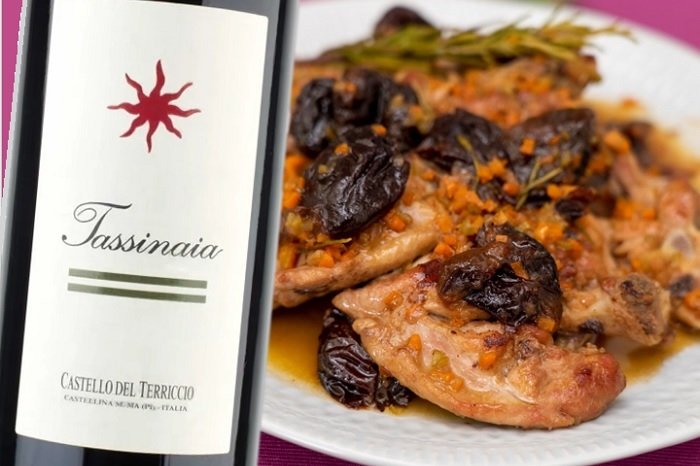Quick and easy recipe made for the European campaign “European Excellence is an Art Form,” featuring European PGI products. We pair it with the 2019 Toscana Rosso Tassinaia Castello del Terriccio.
Ingredients for 2 persons:
6 over chicken thighs; 1 red onion; 1 carrot; 1 celery stalk; 1 glass of pale ale; 8 pruneaux d’Agen PGI (the well-known plums from France); Extra virgin olive oil to taste; Salt; Black pepper; Rosemary, to taste.
Directions:
Salt and pepper the over-thighs. Brown them well in the pan, starting with the side with the skin first.
Remove the chicken from the pan and add the vegetables (celery, carrot, onion) cut into brunoise and brown them well.
Now add the chicken and let it go, then deglaze with the pale ale and add the Agen plums.
Continue cooking until the chicken is well caramelized.
With the heat off, add chopped rosemary and serve.
 Wine pairing:
Wine pairing:
(by Stefania Vinciguerra)
Toscana Rosso Tassinaia 2019 Castello del Terriccio
Dark ruby red. Intense, spicy aroma with notes of green pepper, aromatic herbs, and berries. Savory and quite full on the palate, with fine tannins and good progression to an intense and convincing finish.
Production area: the Pisan hills overlooking the sea on the coast between Castiglioncello and Bibbona. The soils where the vineyards are located are characterized by various and composite morphologies with strong presence of stones and fossils; the altitude is between 100 and 300 meters above sea level, with south/southwest exposure.
Grape varieties: 60% Cabernet Sauvignon, 40% Merlot. Spurred cordon training system, planting density: 5,600 vines/Ha. For old vineyards; 6,250 vines/Ha. for new vineyards
The Climate of 2019
Climate trend: The 2019 ‘vintage was characterized by highly variable weather, alternating periods of cold and rain with long dry and hot spells. After a normal winter, budding occurred in the first week of April. Cold and rainy conditions throughout April and May greatly slowed vegetative development. June suddenly brought very warm and rainless weather with temperature peaks of 37°C. Throughout the summer, the weather remained warm and sunny with temperatures about 2°C above average and 45 consecutive days without rain. In the last week of July the long dry spell was interrupted by two days of rain, allowing the temperature to return to the seasonal norm, with ideal conditions for ripening.
Harvest: Started slowly on September 5 and finished the third week of September.
Production processes: Extremely soft pressing and destemming. Fermentation in temperature-controlled steel vats, with grape maceration for about 9-12 days for Merlot and 12-15 days for Cabernet. During fermentations subsequent pumping over and délestages. It is aged in separate masses by variety, in second- and third-passage French oak tonneaux for 16 months. After being assembled and bottled it rests another 12 months in the bottle before being marketed.
Alcohol content: 14% vol.
Serving temperature: 16-18°C.





